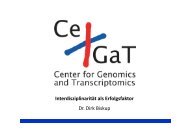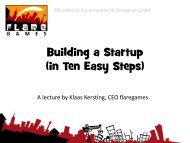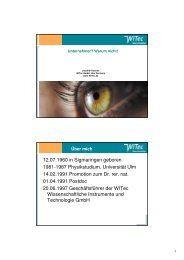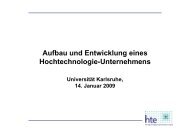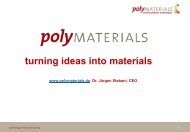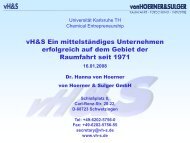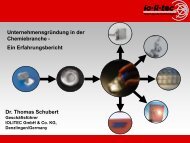Education in Chemical Entrepreneurship - KIT - Technology ...
Education in Chemical Entrepreneurship - KIT - Technology ...
Education in Chemical Entrepreneurship - KIT - Technology ...
Create successful ePaper yourself
Turn your PDF publications into a flip-book with our unique Google optimized e-Paper software.
other resources needed to exploit the opportunities, execute their bus<strong>in</strong>ess plans, and<br />
manage the risks <strong>in</strong>herent <strong>in</strong> any new venture. However, Fiet (2001) underl<strong>in</strong>es the<br />
need not to forget the relevance of deductive learn<strong>in</strong>g, mean<strong>in</strong>g that traditional<br />
lectures based on theory should still represent the core of entrepreneurship courses.<br />
For teach<strong>in</strong>g the curriculum is based on a course and workshops, both modes<br />
<strong>in</strong>volv<strong>in</strong>g Participant-Centered Learn<strong>in</strong>g (PCL). The course adopts a lecture approach<br />
focus<strong>in</strong>g on (NTBF) cases to underp<strong>in</strong> general concepts, but also special approaches<br />
and issues <strong>in</strong> the company's development; however, without related “read<strong>in</strong>g lists” for<br />
students. Lectures are occasionally <strong>in</strong>terrupted for ten m<strong>in</strong>utes for dialogues and<br />
“group discussions”, usually to elaborate concepts, classifications and issues based<br />
on selected short texts provided to the attendees dur<strong>in</strong>g the preced<strong>in</strong>g lecture. Practical<br />
bus<strong>in</strong>ess <strong>in</strong>structions for particular situations are <strong>in</strong>terspersed <strong>in</strong>to the lectures <strong>in</strong> terms<br />
of “check lists”, often formulated as questions and sometimes generated <strong>in</strong>teractively<br />
with attendees.<br />
Cases <strong>in</strong> the context of technology entrepreneurship are also important to <strong>in</strong>troduce<br />
the taxonomy of technologies, such as platform, generic, enhanc<strong>in</strong>g, enabl<strong>in</strong>g, pac<strong>in</strong>g<br />
technology etc. (Runge 2006: 621), and to elaborate technology type related<br />
commercialization strategies as well as competitive positions (“opportunities and<br />
threats”). This transformation of “academic knowledge” <strong>in</strong>to “practitioner<br />
knowledge” (Davidsson 2002) represents a typical example for the current “Theoryto-Practice”<br />
approach.<br />
The cases provide a further construct for successful implementation of our<br />
pedagogical strategy. A “complete” case <strong>in</strong> our particular situation <strong>in</strong>cludes also<br />
biographies or biographical “snapshots” (“story-tell<strong>in</strong>g”), which is narrative<br />
knowledge and often reflects non-l<strong>in</strong>earity of entrepreneurial processes and decisionmak<strong>in</strong>g<br />
(Fillis 2007). Biographies can be used as role models and substitute for<br />
personal advice for entrepreneurs. A number of chemistry-related entrepreneurial<br />
biographies are found <strong>in</strong> Runge (2006). And <strong>in</strong> the UK on its “Support for Small<br />
Bus<strong>in</strong>ess” Web section 9 the Royal Society of Chemistry provides also biographical<br />
<strong>in</strong>formation <strong>in</strong> the sub-sections “Meet the Entrepreneur” and “SME of the Month”.<br />
To “experience” entrepreneurship <strong>in</strong>vited guest speakers from <strong>in</strong>dustry provide<br />
lectures (<strong>in</strong> German) on <strong>in</strong>novation, new bus<strong>in</strong>ess development and the<br />
<strong>in</strong>trapreneurship part of the course 10 as opposed to guest lectures of “real”<br />
entrepreneurs 11 . The entrepreneurs provide special cases with entrepreneurial<br />
biographies, backgrounds and found<strong>in</strong>g constellations and generate further <strong>in</strong>sights<br />
through Q&A <strong>in</strong> complet<strong>in</strong>g the lecture or <strong>in</strong> meet<strong>in</strong>gs with the entrepreneurs after the<br />
lecture. Students appreciated <strong>in</strong> particular the emotional and subjective parts when<br />
entrepreneurs spoke about threats for the existence of their startups, personal errors<br />
and failures and advices and assessments concern<strong>in</strong>g political startup programs and<br />
f<strong>in</strong>ancial backers for the startup.<br />
Concern<strong>in</strong>g content, the course follows a modular approach with fourteen weekly 90<br />
m<strong>in</strong>ute meet<strong>in</strong>gs <strong>in</strong>clud<strong>in</strong>g four lectures by guest speakers. The “permanent” thirteen<br />
modules presented by the <strong>KIT</strong> <strong>in</strong>structor are given <strong>in</strong> Table 1. In the sense of MIT<br />
Open CourseWare all the lectures are publicly accessible via the <strong>Chemical</strong><br />
<strong>Entrepreneurship</strong> Web site.<br />
The course modules are “self-sufficient” and refer to multiple bus<strong>in</strong>ess discipl<strong>in</strong>es<br />
(Table 1): strategy, management, market research, market<strong>in</strong>g, and f<strong>in</strong>ance and<br />
Runge and Bräse - 11 -



